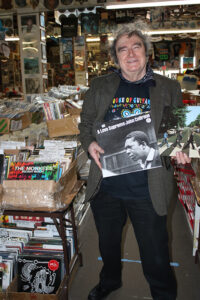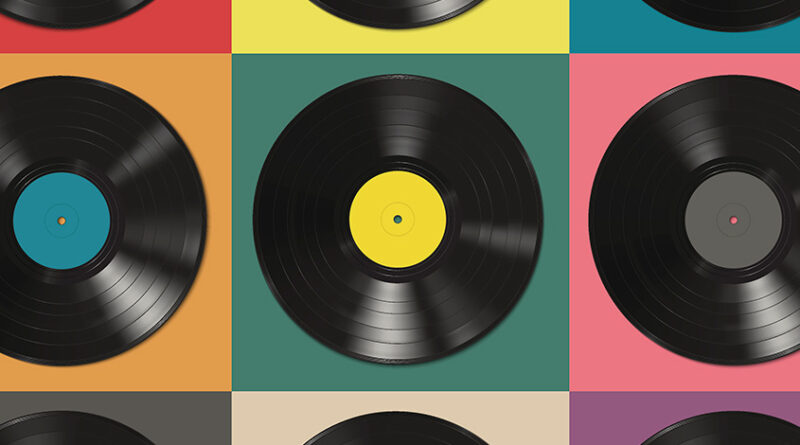Remember Vinyl?
By John Addyman
Vinyl is back, with a devoted audience of old and new aficionados alike.
On Thursdays, Jon Cooley is a happy man.
“Every week I have new records coming in on Thursdays,” he said from his Canandaigua Record Exchange store. “For me, that’s Christmas every week. I listen to new music, check out new bands and when the UPS truck rolls up (rubs his hands gleefully), I get my box-cutter out and I’m a happy boy — let’s see what the new stuff is.”
That’s the first step.
“On Thursday I send out a newsletter by email, on Spotify, in my podcast, talking through the new releases for Friday, he said. “Thursday night on the social media channels I do a flip video, a video of me flipping through the new records in a crate — what’s available on Friday. People grab their popcorn and watch.”
Wait a minute. Is he talking about records? Vinyl?
Isn’t vinyl dead?
Far from it.
Margaret Storms, who is the manager in the vinyl department at Record Archive in Rochester, was at a music business national conference in Nashville in mid-May. “Sales of vinyl are up 27% across the market,” she said. “And 41% of people buying vinyl are 13-24 years of age, 50% are female and 27% are Hispanic, 76% of vinyl buyers own their own turntable.”
That doesn’t sound like 2022. It sounds like 1968.
Storms is the daughter of Richard Storms, co-owner of Record Archive. She was working at her dad’s store as a teen. The store was opened in 1975 and survived when vinyl sales dropped off the end of the earth starting in the 1980s as CDs, iPods, iTunes and streaming services came to be.
“I’ve seen demographic shifts in who’s buying records,” she said. “When I first started here in 2005, I would see blues and jazz record collectors who were younger baby boomers, I would see punks coming in to buy records and deejays coming in to buy records. That was about it. If you were shopping with us, you were mostly buying movies or CDs.
“We definitely did fight tooth and nail to keep physical media present in our region’s marketplace,” she said, sitting in an office surrounded by photos and band memorabilia. “We did have to try different things alongside to keep it going during the down years. We leaned into gifts, we opened up event space. Then we were smart with how we staffed and what we bought.”
She said Record Archive “made sure we served the community so they felt they wanted to keep doing stuff with us. We got involved in local charity things, inviting people from the community to come in and do stuff with us. We used to do swap meets in the parking lot and opening the [performance] venue has been great because we’ve been able to book a ton of local bands now, enmesh ourselves more in the local music community even more than we did before.”
“There were a lot of different facets we did to make sure we could survive the 2000s. The challenge was, how do you make someone want to come into the store when they could literally get music for free at home. It became a lot about the atmosphere and the environment and the experience of going to a record store more than actually buying something at the record store. That has changed a little bit since the vinyl resurgence started — I think it really kicked in in 2017, 2018 when it really started to tick up.
“But the last three years for us have been a shocking blessing. The pandemic has caused the most insane growth in vinyl. I was looking at some numbers recently: over the last 20 years, vinyl sales have increased 33 times over.”

Another veteran
Someone who not only dealt in vinyl but produced it himself is Armand Schaubroeck, who opened House of Guitars in Rochester with his brothers, Bruce and Blaine, in 1964.
From the start, the Schaubroecks were crafty: they stocked their new store with the kinds of guitars and amps the Beatles used and guess who showed up on our New York shores in 1964?
“We had vinyl records right away,” he said. “We had excellent timing. We opened in ‘64 and the Beatles came to American in ‘64. We were carrying all the English bands, but also carrying the 1950s 45s. Back in the ‘50s, an album was too expensive, you kinda bought a 45 to get the hit song you heard on the radio, with a ‘B’ side on it. Then they started making miniature albums that cost just a little bit more, EPs, with four songs or five songs and still under $2.”
Schaubroeck watched the vinyl business change and almost disappear. A new mode of business arose — selling used records. Today when you venture to the base of the store, past all the magnificent guitars, you find a warehouse of records, CDs and DVDs. The organization appears a little loose, but frankly, that’s part of the charm.
“Tell us what you’re looking for,” Schaubroeck said, “and we’ll take you to it or bring it to you,” admitting the enormous collection is a little spread out.
And the surge in vinyl is hard to corral.
“The market is exploding,” Schaubroeck said, his voice reflecting continued surprise. “People like the sound of vinyl. When people buy an album, they’re actually buying that period in that band’s life. They like to read about all of it inside, all the notes, figure out how Duane Allman sounded compared to the new Allman Brothers lead player. They really get into it.
“If the vinyl resurgence hadn’t happened,” he warned, “we might only have a choice of one song from a download. The record companies or the groups wouldn’t bother making an album, they would make one hot song for a download and skip the expense of putting out a whole album.
“Because of vinyl coming back, it’s keeping music alive,” he believes, and he’s recorded — and still sells — some of his early recordings. “A lot of people are still buying CDs, too. Vinyl has an analog sound that kind of smooths what was recorded. It was recorded with tape and when you hit play-record the tape stretches — each time the tape stretches a little and smooths it out. Digital comes out real clean, but it’s right in your face. Loud and right at you. Digital is very clean, but it’s different from vinyl.”
But why vinyl now?
“Our society is racing all the time now, holding two jobs, we’re in a rat race trying to make ends meet, supporting our families and everything,” Schaumberg said, sitting on a chair surrounded by records. “Vinyl itself…you have a little room, a little time, where you can relax and remind yourself of slower days back when you took the time to just turn it all off and listen to a record. Music can make you forget all your problems.
“You listen to a couple of hot songs in a row you’re right there, back in your glory days in the 1960s. If you’re an attorney or a real estate agent or something, you can escape to your little room with your stereo, turn the TV off and slow things way down with an album. It’s the best way I can describe it.”
Storms said playing a vinyl record is a process of “intentionality” — it’s something you mean to do; it’s not background music.
“Playing a record forces you to pay attention to the music and it sounds better because you’re taking the time to give it attention and share intention with it,” she said. “If you’re streaming something, you just kind of hit play and walk away. Records force you to touch the artwork, pull the album out, babysit it a little to turn it over halfway through — it’s a more involved experience – you’re getting more from the music because you’re forced to pay attention to it.
“I think people really took to vinyl for those reasons during the lockdowns: it sort of filled the gap that seeing live music does because it’s a very intentional music experience…you’re making it a point to go see music. Care and intentionality can be replicated at home with vinyl.”
“It is the experience,” agreed Cooley of Canandaigua Record Exchange. “When you have your favorite record, something you really, really love, you grab it, open it up, get to smell it. Everybody has old originals. You have to put it on the turntable. You have to pick up the needle and drop it down — very gently of course. You start the process, on your time. And you sit down and you listen about 20 minutes, get up, flip the record over, sit back down and listen to the other 20 minutes. That might be the only record you listen to that day, but you’re part of the process, almost like the fifth or sixth band member. You have the big record jacket to look at the artwork and the liner notes and you can actually read them instead of getting out a magnifying glass, like for a CD or cassette.”

Intergenerational shoppers
Schaubroeck and Storms are veterans in the vinyl business. Cooley just came to it two years ago when he opened his store.
With what was an apparent demise of vinyl, was that a mistake, a risk?
“It was a calculated risk,” he said.
Cooley had corporate experience and local automotive experience. And he had data — a graph that shows vinyl sales increasing every year for the last 15. “Even if I just sold records, it’s good,” he said. “I can make sure this business not only brings records to Canandaigua and the surrounding area, but will also be able to support me and my family.”
He figures his is the record store for the Finger Lakes because it’s so close to towns south of Rochester.
As for what he sells, “Everything is hot right now except for classical music,” he assured. “There are 400 albums released each week on vinyl. People don’t realize that. Most of it is reissues because the major labels have gotten back involved. I know if I get any Grateful Dead vinyl, it sells. The big names – Pink Floyd, Led Zeppelin, the Beatles — they are always safe bets.”
Canandaigua Record Exchange is a very small shop, but focused. Record Archive feels more organized and the staff is very experienced, plus you can hear live music on Wednesday evenings and just about anytime, do your record-searching with a lovely amber beverage or wine in your hand. House of Guitars feels like so many older record stores where you just knew you’d uncover a treasure if you stayed at it, and it, too has a music venue that is a constant draw for musicians.
Accepting that vinyl is back, OK, why is vinyl coming back so strongly?
“It’s a testament to the togetherness of listening to music,” Storms believes. “The younger generations are really into making sure they are directly supporting artists. This is a generation that’s grown up streaming and listening to music on YouTube or iTunes or Spotify, now they want make sure the artists they love are supported and they’re aware that things like vinyl, merchandise and seeing them in live performance does make a difference to the artists and they’re coming into the stores to buy records to directly support those artists.”
Storms sees today’s vinyl buyers as a new breed. “Intergenerational shoppers are coming in now. Parents with children and their grandchildren, walking around and recommending music to each other and swapping who’s listening to what record — and they all love Fleetwood Mac. It’s super, super heartwarming to see a 16-year-old talking to their 45-year-old parent, with their 65- or 75-year-old grandparent, all bonding over record-shopping together. It warms my heart genuinely.”
From his historical perspective, Schaubroeck has also watched the demographics change. “The change back to vinyl started out when people were buying their favorite record, even though they had the CD. It kind of exploded from there. Then it was college kids. Now it’s high school kids. They come in for a certain Duran Duran album in great shape or new and they have started to get into the sound of vinyl itself, because it is different,” he said.
He said the jazz market has recently gotten very healthy, with buyers seeking more obscure titles from Coltrane, Brubeck, Sun Ra and Joe Pass. His classical music customers are a quieter, more studious breed. “They don’t want to be approached,” he said. “They just want to look at the records. The jazz people ask us for help because a lot of things are in spots they can’t get to on our floor. They just tell us what they’re looking for and we put it in their hands so they can decide.”
Behind the scenes, Schaubroeck and the others are fighting for music customers want but is unavailable. “The record companies aren’t interested in anything unless it’s making them a million dollars,” he said. “They don’t care about small markets very much. There are so many albums they’re still not making. We’re looking for the best used in the best shape to buy so we can resell them because you can’t get a new one often. They might put an album out for a little while then take it right out of print. They sell just so many then it goes out of print again.”
That means stores depend on reissues from European or Asian markets, where companies are willing to produce copies of a vintage album. The problem then becomes delivery and production costs.
Is vinyl alive? Oh, yes.
And record-shopping?
“The Rochester community believes we are valuable to them,” Storms said. “People saw Record Archive and other records stores — we’re all part of the same ecosystem, I believe — as a good place to spend time, someplace they want to go to, not just to buy something, but as a destination to hang out in or go meet your friends at the record shop, or just get out of the house and do something that will reset how you’re feeling. It feels good to go to the record store.”

